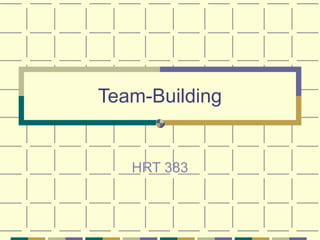
Team building _norms_108
- 1. Team-Building HRT 383
- 2. Thanks to: Ken Blanchard, Patricia Zigarmi, & Drea Zigarmi, authors of Leadership and the One Minute Manager Ken Blanchard, Donald Carew, and Eunice Parisi-Carew, authors of The One Minute Manager Builds High Performing Teams R. B. Lacoursiere, author of The Life Cycle of Groups: Group Developmental Stage Theory
- 3. Thanks to: Stephen P. Robbins, author of Organizational Behavior: Concepts, Controversies, and Applications Tools for Teams: Building Effective Teams in the Workplace, edited by Craig Swenson Robert H. Woods and Judy Z. King, authors of Quality Leadership and Management in the Hospitality Industry Gary Yukl, author of Leadership in Organizations
- 4. Individual Development Competence Knowledge Skill Commitment Confidence Motivation
- 5. Individual Development Stages D4 D3 D2 D1 High Commitment Competence Low From "Leadership and The One Minute Manager"
- 6. Coaching Choices Directive Behavior “Autocratic” Supportive Behavior “Democratic”
- 7. Coaching Stages Directing Structure, organize, teach & supervise Coaching Direct and support Supporting Praise, listen & facilitate Delegating Turn over responsibility for decision-making
- 8. Situational Leadership II The Four Leadership Styles (High) S3 S2 Supporting Coaching Supportive Behavior S4 S1 Delegating Directing (Low) Directive Behavior (High) High Moderate Low D4 D3 D2 D1 Developed Developing Development Level of Followers From "Leadership and The One Minute Manager"
- 9. Group Development Orientation Called “Forming” in Robbin’s model Uncertainty about purpose, structure & leadership Members are “testing the waters” Dissatisfaction Called “Storming” in Robbin’s model Characterized by intragroup conflict Members accept the existence of the team, but individuals resist the constraints on their individual style
- 10. Group Development Resolution Called “Norming” in Robbin’s model Characterized by cohesiveness, identity, structure, and a set of expectations Members develop closer relationships Productivity Called “Performing” in Robbin’s model Structure of the team is fully functioning Members’ energy has moved from getting to know phases to getting the work done
- 11. Group Development Robbin’s model includes a final phase called “Adjourning” This would be characterized by a temporary committee completing a task or achieving results based upon a goal Your team may go through these five stages twice…
- 12. Group Developmental Stages GDS4 GDS3 GDS2 GDS1 Production Resolution Dissatisfaction Orientation High Morale (Commitment) Productivity (Competence) Low From "One Minute Manager Builds High Performing Teams" Adapted from "The Life Cycle of Groups: Group Development Stage Theory"
- 13. Situational Leadership II The Four Leadership Styles (High) S3 S2 Supporting Coaching Supportive Behavior S4 S1 Delegating Directing (Low) Directive Behavior (High) High Moderate Low G4 G3 G2 G1 Developed Developing Development Level of the Group From "One Minute Manager Builds High Performing Teams"
- 14. Group Orientation / Forming 382 Instructor formed the initial teams The Management Plan process was designed to help you frame your purpose Instructor(s) offered insight into structure, but what your team did/does and how it got/gets accomplished was/is your business Round I in 382 & Round II in 383
- 15. Group Dissatisfaction / Storming What did your team experience in Round I? Where was your storm? The team itself? One individual? Your management position? Your week of management? Formal vs. informal leadership? In Round II (383), any “storms” are usually weaker!
- 16. Group Resolution / Norming Behavioral Norms Team “Code of Conduct” Examples: Consensus Communication Commitment Conduct What did you learn in 382?
- 17. Group Production / Performing In 382, getting the management plan done Why not just jump right in? Creating a guiding purpose Team Philosophy Team Mission Was your team fully functioning?
- 18. Group Adjournment Temporary break between quarters 383 – Round II Forming Storming Norming Performing Adjourning
- 19. Types of Teams Functional Operating Team Cross-Functional Team Self-Managing Team Self-Defining Team Top Executive Team
- 20. Types of Teams Functional Operating Team Formal Leader Members with similar, but specialized functions Example: Maintenance crew, SWAT team, sports Cross-Functional Team Usually has a formal leader Members with different functions – various stakeholders Example: Team to begin HACCP or TQM program, or to kick-off a new promotion
- 21. Types of Teams Self-Managing Team No formal leader - leadership may rotate Membership: similar functions External leader, in the same organization, to direct, coach, support, and delegate 382 is similar to this model
- 22. Types of Teams Self-Defining Team No formal leader - leadership may rotate Facilitator acts as leader – role rotates Membership: similar goals or business purpose, but specialization of roles is possible Examples: Moosewood Restaurant, 383 Top Executive Team
- 23. Common Characteristics Functional Cross Self Self Top Operating Functional Managing Defining Executive Autonomy- Low Low-Mod Low High High mission Autonomy- Low-Mod High High High High procedure Authority- High High Low Low High internal Duration High Low-Mod High Variable High Stability High Low-Mod High Variable High Functional Low High Low Variable High diversity
- 24. A fully functioning team can… Work together successfully Solve problems and reach decisions in a way that incorporates individual input Reach decisions through consensus Can adapt to change Achieve or exceed desired results
